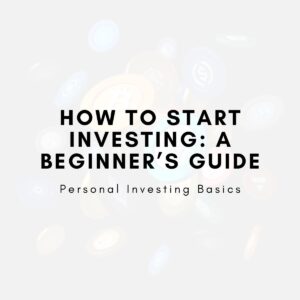
How can you start investing with little money?
It may seem difficult to invest with limited funds, but it’s entirely possible with the right strategy. Whether you’re starting with a small amount or don’t have much saved up yet, there are plenty of investment options that allow beginners to grow their wealth gradually. From high-yield savings accounts to investing in low-cost index funds, the key is consistency, patience, and making informed decisions. Read on to explore the steps you can take to begin investing today, even with little money.
Summary Table: How to Invest with Little Money: Tips for Beginners
| Section | Summary | Key Tips | Examples |
|---|---|---|---|
| Why Start Investing with Little Money? | Starting early allows your money to grow over time through compounding. Small, consistent contributions can lead to significant growth. | Time is an investor’s best friend; the earlier you start, the better. | Sarah starts with $500 and deposits $50 monthly into a high-yield savings account, growing her savings to over $4,000 in 5 years. |
| Investment Options for Beginners | High-yield savings accounts, robo-advisors, and ETFs are accessible to those with little money to invest. | Choose low-risk and diversified investment options. | John invests $200/month with a robo-advisor, growing his portfolio to $35,000 over 10 years. |
| Maximizing Returns with Limited Funds | Focus on low-cost investment vehicles like ETFs and utilize dollar-cost averaging to reduce the effects of market volatility. | Stick with low-fee investments and automate contributions. | Emily invests $1,000 in an ETF tracking the S&P 500, growing her money to $1,750 in 5 years. |
| Investment Mistakes to Avoid | Avoid chasing high returns with risky investments, and make sure to have an emergency fund in place. | Prioritize building a stable emergency fund before investing. | Tom loses 60% of his investment by chasing a penny stock, while a diversified ETF portfolio would have provided more steady growth. |
| Conclusion | Investing with little money is entirely possible; the key is consistency, diversification, and long-term commitment. | Start small, stay consistent, and diversify your investments. | By following a simple investing strategy, you can build wealth over time even with minimal initial capital. |
This summary table breaks down the essential points from the guide on how to start investing with little money. Each section provides a brief summary, key tips for beginners, and real-life examples to show how small, consistent investments can grow over time.
Introduction
Investing can seem like a daunting task, especially if you don’t have much money to get started. However, the reality is that you don’t need a lot of capital to begin building your wealth. Whether you’re a young professional just starting out or someone who’s just beginning to understand the importance of personal finance, investing with little money is not only possible but can be incredibly rewarding in the long run.
Many people are intimidated by the idea of investing because they believe they need a large sum of money upfront. While having more money to invest may help accelerate wealth building, the truth is that it’s better to start with small, consistent contributions rather than waiting until you have a large amount to invest. In this guide, we will walk you through the steps to start investing with little money, provide tips on how to choose the best investment options, and show you how to make your small investments work for you.
Why Start Investing with Little Money?
The Importance of Time in Investment Growth
One of the primary reasons to start investing with even a small amount of money is the power of compounding interest. The earlier you start, the more time your money has to grow. For example, if you invest $100 each month in a low-cost index fund that returns an average of 7% annually, in 30 years, you could have over $100,000 without ever increasing your monthly contributions. This highlights the importance of time in making your money work for you.
Small Contributions Add Up Over Time
Even if you only have a small amount of money to invest, the key is to stay consistent. By committing to invest small amounts regularly, you will be building a habit of investing, which can pay off in the long term. For example, if you start with just $25 per week, you’ll be investing $1,300 per year. If that grows at an average return of 6% annually, over 10 years, you could see your investment grow to more than $20,000.
Investment Options for Beginners with Little Money
1. High-Yield Savings Accounts and CDs
If you’re just getting started, one of the easiest ways to begin investing with little money is by opening a high-yield savings account or a Certificate of Deposit (CD). These options are low-risk and offer a higher interest rate than a regular savings account. While the returns may not be massive, they provide a safe way to start saving and investing, with no need for large initial investments.
Example:
Sarah, a 25-year-old starting her career, opens a high-yield savings account with $500. She deposits $50 every month, earning 1.5% interest. After 5 years, she has accumulated over $4,000 in savings, plus interest, allowing her to begin more aggressive investing later on.
2. Robo-Advisors
Robo-advisors are a great option for beginners with limited funds. These online platforms use algorithms to automatically create and manage your investment portfolio, based on your risk tolerance and investment goals. Robo-advisors typically require little to no minimum investment and offer low management fees, making them a cost-effective and simple option for first-time investors.
Example:
John, a 30-year-old, invests $200 a month in a robo-advisor like Betterment. Over 10 years, his portfolio grows to $35,000, even though he started with just $200 per month and didn’t have to worry about managing his investments actively.
How to Maximize Returns with Limited Funds?
Focus on Low-Cost Investment Vehicles
When you don’t have much money to invest, it’s crucial to choose investment vehicles that won’t eat into your returns with high fees. Low-cost index funds and exchange-traded funds (ETFs) are ideal for beginner investors. These funds pool money from many investors to buy a diversified mix of assets, offering a way to invest in many companies or sectors without having to buy individual stocks. Most importantly, they come with low fees, which can have a significant impact over time.
Example:
Emily invests $1,000 in a low-cost ETF that tracks the S&P 500. With an average return of 7% per year, her investment grows to $1,750 over the next 5 years, helping her build a strong foundation for future investments.
Dollar-Cost Averaging Strategy
Another strategy to help maximize returns with small amounts of money is dollar-cost averaging (DCA). This method involves regularly investing a fixed amount of money in an asset, regardless of the asset’s price. By doing so, you avoid trying to time the market and ensure that you are buying in both high and low market conditions, which can reduce the risk of market volatility.
Example:
Tom invests $50 each month into an ETF that tracks the total stock market. During months when the market is down, his $50 buys more shares, while during months of growth, his $50 buys fewer shares. Over time, this strategy helps him smooth out the volatility and invest at different price points, increasing the average return.
Investment Mistakes to Avoid When You Have Little Money
Chasing High Returns with High Risk
It can be tempting to look for high-risk investments that promise large returns, but this can be dangerous, especially when you have limited money to invest. Many beginners make the mistake of jumping into risky options like individual stocks or cryptocurrency without fully understanding the risks involved. Instead, focus on building a well-diversified portfolio and gradually increase your risk exposure as your knowledge and capital grow.
Example:
Tom, a new investor, is tempted by the high returns of a penny stock that’s been trending on social media. He invests $500 without understanding the risks, only to lose 60% of his investment in a short period. If Tom had stuck with a diversified portfolio of index funds, his money would have grown steadily over time.
Ignoring Emergency Savings
Before investing, it’s essential to ensure you have enough emergency savings. Having an emergency fund of 3 to 6 months’ worth of living expenses will give you peace of mind and prevent you from needing to sell investments in a financial crisis. Always prioritize building your emergency fund before committing to investments, even if they seem appealing.
Conclusion
Starting to invest with little money doesn’t have to be intimidating. The key to success is to begin early, stay consistent, and focus on building a diversified portfolio with low-cost investment options. By using strategies like dollar-cost averaging, investing in index funds or ETFs, and avoiding high-risk, high-reward investments, you can grow your wealth over time, even with limited funds. Remember, it’s not about how much you invest right now, but about starting with what you can and continuing to build over time.
Key Takeaways
- Start early: The earlier you begin investing, the more time your money has to grow due to the power of compounding.
- Consistency is key: Small, regular contributions can add up over time, helping you build a significant portfolio.
- Low-cost options: Focus on low-fee investments like ETFs, index funds, and robo-advisors to maximize your returns.
- Dollar-cost averaging: Invest a fixed amount regularly to reduce the impact of market volatility.
- Avoid high-risk bets: Stick with diversified, low-cost investments rather than chasing risky, high-reward opportunities.
- Build an emergency fund: Make sure you have 3-6 months of expenses saved before diving into investing.




